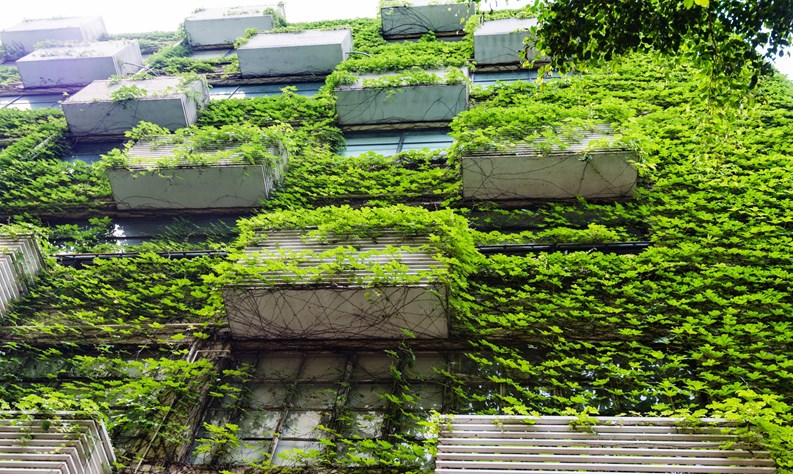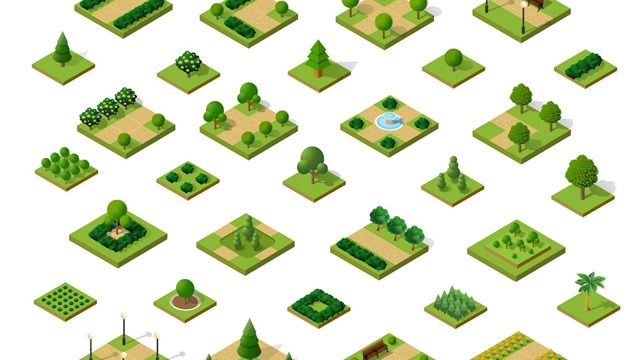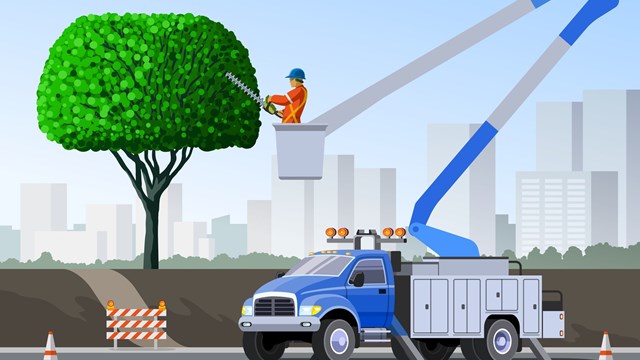When the sun seems to shine a bit brighter, warmer, and longer, and the first buds of spring start to appear on trees and bushes, many multifamily property managers, boards, and residents start to think about the landscaping at their building or HOA. After months of being cooped up indoors and unable to make full use of their outdoor spaces, the arrival of spring reminds them that these areas are there—and that they need some serious TLC—or maybe even overhaul—after a long, cold winter.
But where should multifamily decision-makers even begin when making landscaping choices? How does the process for reseeding a vegetable garden differ from redesigning a courtyard? It turns out that a proper plan—and adequate time to finalize, procure, and implement it—is crucial to get the most out of a property’s outdoor space on any budget. We spoke to several landscaping professionals and organizations to find out what boards, managers, and gardening committees should keep in mind when developing a landscaping plan for their communities. Different pros had their own recommendations, but all agreed that the time to start thinking about them is now.
How Will the Space Be Used?
As opposed to individual homeowners who have only their own households to consider when making landscaping decisions, multifamily buildings and associations have to consider multiple, diverse households; what might be an appealing use of space to one segment of the community might be completely unsuitable to another. Community leaders may have a lot of different backgrounds, ages, interests, and abilities to consider when weighing how their shared outdoor spaces will be used, what they will look like, and how they’ll be designed.
David Mendelson and Annamaria Morales are principals with QG Landscape in New York, and are well-versed in collaborating with boards and committees to make use of outdoor areas. Where possible, they suggest trying to carve out sections of space for different purposes: shaded nooks for passive activities like reading or meditating; paved areas for high-impact games or groups; planters and shrubs to separate areas and provide visual interest. Even small spaces can be designed in a way to maximize usage and accommodate different populations; unsurprisingly, the coronavirus pandemic has accelerated some of this thinking. While private outdoor space has always been a highly sought-after amenity in a dense urban environment like New York City, a whole year-plus of staying home and keeping socially distant has put an even higher premium on convenient access to fresh air and greenery.
“I have a client building on the East Side [of Manhattan] that had this dead space in the back of the building,” says Morales. “All of a sudden, they’re like, ‘This is dead space, we’re doing nothing to it. Let’s put up a nice fence around it; let’s put some pavers down. Let’s put a couple of benches.’ And now the kids have somewhere to run and play; the parents have an area to be able to get some fresh air. We’re also incorporating some planters with some greenery to kind of separate little seating areas.”
And that building community is far from alone in their desire to enliven unused or underused spaces. “People are now realizing, ‘Hey, let’s make the best of this dead space,’ ” Morales continues, “or, ‘Let’s revamp our space to accommodate today’s needs.’ ”
On top of considering the community’s population and pandemic-related needs, co-ops and condos also have to factor in a unique slate of physical and logistical considerations as well. “With respect to an interior, on-grade courtyard,” says Mendelson, “you can have issues where maybe it’s adjacent to residents’ apartments or spaces. So you have to mitigate what you’re going to do in the space because it is next to someone. You clearly don’t want to have dogs and children running around making a lot of loud noise adjacent to people’s units.” Mendelson also cautions about the need for thoughtful placement of lighting for the same reason—nobody wants a floodlight pouring through their bedroom window all night. Additionally, urban buildings have to contend with what may lie beneath their foundations—from utilities to parking to telecommunication cables to mass transit infrastructure. What’s down there can dictate what can be planted or built on a given site.
What About Local Climate and Soil Conditions?
The overall climate of a region will be a major determining factor in landscaping choices for any multifamily community or individual homeowner. A desert region like Las Vegas looks a lot different from a tropical climate like Florida or a temperate region like the Northeast. Even within these general climates, microclimates and the particular topography of a specific area will influence what can be grown and where. In urban areas, height and density of buildings creates shadows, wind tunnels, and water runoff that must be factored into landscaping design and maintenance.
EPA.gov, the website of the Environmental Protection Agency (EPA) advises that “when planning your landscape design, in addition to primary use, also consider factors such as local climate, sun and shade locations, and the maintenance schedule. This plays a big part in how often your landscape receives rainfall and whether your plants must be prepared for a warm or cool climate. Although the plant choice will depend on the region, you can still have an attractive, functional landscape with water-efficient plants.”
This is another area where a professional landscape designer or horticulturalist can offer your association or building expert advice—which ultimately can save a lot of money and headaches in the long run. According to Debbi Edelstein, executive director of the New England Wild Flower Society in Framingham, Massachusetts, “It’s always a good idea to find a professional who is up to speed on environmentally friendly landscaping and sustainable practices. One of the main reasons to go with a professional is because most of them have done their homework on the combination of science and aesthetics—the science of how to root trees, for instance—and they’ll know how to plant things so they’ll thrive more.”
What Is the Budget?
Kristen Deinhardt-Faught, an account manager with BrightView Landscape Services based in Oceanside, New York, says that budget is one of the first things she discusses with a client when taking on a landscape project. The costs associated with landscaping can range widely, and encompass a variety of services. Deinhardt-Faught emphasizes that different tiers of service call for different budgeting approaches. For example, lawn maintenance may or may not include irrigation. Some contracts include tree care; some don’t. The scope of design has to factor in the costs of the design plan itself—not just the material and plant choices and the installation, but the ongoing maintenance as well. For clients with more limited budgets, or who have new concerns in light of COVID, Deinhardt-Faught suggests phasing larger projects or enhancements over time. “If you’re looking to do enhancements,” she says, “like a large-scale project, we can phase it out for you—you can do one phase the first year, and another phase of the project another year. And we’ll just work with [a client’s] budget as much as we can. We try to at least give them something for what they’re looking for.”
Morales agrees, and adds that there can be a bit of a learning curve for some boards in terms of how much they have to spend and over what timeline. “We need to know how much they have to spend—and sometimes these boards don’t know what things cost,” she says. “They’ll say, ‘Well, we only have $100,000,’ and then we’ll go to a site meeting and they’ll be talking about powder-coated aluminum planters; they want to do ipe [wood] decking and an ipe fence, and pavers; and it’s like, ‘That’s great—sounds beautiful! But your budget can’t give you that.’ So we find a happy medium.”
For this reason, Morales adds that it’s a good idea to include more than one decision-maker in meetings and site visits with the landscaping vendor. Ideally, the team should at least include the property manager, but could also include key maintenance personnel or supers, executive board members (or the entire board, depending on the size of your community), and any non-board residents who participate in grounds committees, gardening clubs, or working groups tasked with landscaping issues or projects. That way, information doesn’t get lost in translation, and the board has more awareness of where the community’s money is going. They can also be educated on the time it takes for certain plants to grow to their full potential and the maintenance involved.
You Dig?
Considering the investment in both time and money that a smart landscaping plan requires, there is no time like the present to get the process rolling. Don’t let the inspiration of springtime go to waste! Consult with your professionals, establish your goals, and once you’ve got a game plan, get digging. The right landscaping choices will provide value and visual appeal for any multifamily community.
Darcey Gerstein is Associate Editor and Staff Writer for CooperatorNews.










Leave a Comment